Design and Voltage Supply of High-Speed Induction - Aaltodoc
Design and Voltage Supply of High-Speed Induction - Aaltodoc
Design and Voltage Supply of High-Speed Induction - Aaltodoc
You also want an ePaper? Increase the reach of your titles
YUMPU automatically turns print PDFs into web optimized ePapers that Google loves.
102<br />
account when calculating the scaling factor ksc. The average temperatures measured for the<br />
windings in Chapter 6 were also taken into account. The estimation model presented in Section 8.3<br />
(Eq. 8.8) was used to calculate the values for ksc.<br />
The current spectra measured in Chapter 6 were modified by square root <strong>of</strong> kcc, thus yielding the<br />
effective current spectra for the power loss. Results for PWM with 15 pulses per half cycle <strong>and</strong><br />
PAM are presented.<br />
Fig. 8.11 shows the average value <strong>of</strong> kcc for the three phase winding as a function <strong>of</strong> frequency. It is<br />
seen that the model gives very high values for kcc. It is clear that the extrapolation from 450 Hz is<br />
inaccurate. It is reminded here that the frequency <strong>of</strong> the fundamental was already 835 Hz. The<br />
coupling between the current distribution, circulatory emf ecc <strong>and</strong> temperature distribution is not<br />
present in the model. If the coupling was modeled, the kcc curve in Fig. 8.11 might saturate at some<br />
higher frequency. Thus, the result on the effect <strong>of</strong> the circulatory currents is only qualitative.<br />
Fig. 8.12 shows the current spectra measured at full load points. It shows that PAM has steadily<br />
decreasing amplitude for the components. The PWM has low amplitudes for 5 th <strong>and</strong> 7 th order<br />
harmonics but higher amplitudes at higher frequencies. The rms-values <strong>of</strong> the harmonic currents are<br />
32.8 A for PAM <strong>and</strong> 20.6 A for the PWM, as measured in Chapter 6.<br />
Fig. 8.13 shows the same spectra corrected with the square root <strong>of</strong> kcc, yielding an effective current<br />
spectra for power loss. It shows how the higher order currents for the PWM have a major effect on<br />
total harmonic content. The rms-values <strong>of</strong> the effective harmonic currents are 175 A for PAM <strong>and</strong><br />
265 A for the PWM.<br />
Using DC-resistance <strong>of</strong> the stator winding, the harmonic loss due to the circulatory currents is<br />
calculated. The effective currents would give harmonic loss <strong>of</strong> 800 W for PAM <strong>and</strong> 1870 W for the<br />
PWM. These loss values are much too high. The total harmonic loss measured in the motor was<br />
only 700 W for PAM <strong>and</strong> 770 W for the PWM.<br />
Even if the values for kcc <strong>and</strong> effective currents are too high at higher frequencies, the result shows<br />
that the circulatory currents could be one thing to decrease the usefulness <strong>of</strong> PWM for high speed<br />
induction machines. On the other h<strong>and</strong>, if the kcc - curve shown in Fig. 8.11 saturates at higher<br />
frequencies, the situation might be different. The harmonic currents <strong>of</strong> 5 th <strong>and</strong> 7 th order could<br />
increase more relative to higher harmonics. Thus, PWM might win the comparison after all. This is<br />
an interesting issue <strong>and</strong> subject for further studies.
















